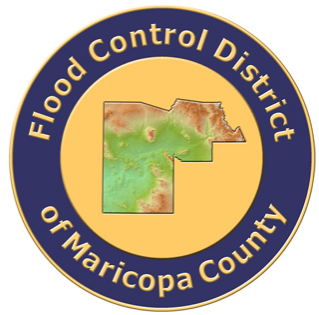Download PDF
Download page Maricopa Method.
Maricopa Method
Version 6.3
These methods will be available in version 6.3
The latest version of HEC-RAS includes the "Maricopa Method" in addition to the USACE method from EM 1601. The Maricopa Method was developed by the Flood Control District of Maricopa County and is described in the 2018 Drainage Design Manual for Maricopa County, Arizona, - Hydraulics (See Section 6.6.3 Riprap Lined Channels). The Maricopa Method is a case-dependent modification of the Ishbash Equation (which is also in the latest version of HEC-RAS). In version 6.3, only Ishbash-related Maricopa County’s riprap sizing equations are implemented. Other riprap sizing equations from Maricopa County will be implemented in the future versions
The Maricopa Method modifies the Isbash equation and calculates the d50 (median size) of the riprap for four cases:
- On the Channel Bed or on the Banks
- For Straight or Curved Channels
The Maricopa Method also includes special equations for several specific design conditions (e.g. downstream of a grade control or drop structure) and assumptions to extend the d50 into a gradation.
Channel and Bank Riprap Equations
The Isbash Equation for Riprap is:
Where:
V=Maximum Velocity (ft/s)
(Estimated at 1.33 times the cross section average velocity in the channel)
Va=Cross Section Average Velocity in the Channel (ft/s) (from HEC-RAS)
(0.86 for high-turbulence; 1.2 for low-turbulence per EM 1601, Appendix F, page F-5)
C=An Empirical Turbulence Coefficient (-)
g=Acceleration of Gravity (ft/s2)
γw = Unit Weight of Water (lb/ft3)
γs = Unit Weight of Soil (lb/ft3)
s = Specific Gravity
The Maricopa Method modifies the Isbash Equation in three ways. It has specific turbulence coefficients (C) for straight and curved reaches, it estimates the maximum velocity (V) as a function of the average velocity (V=1.33Va) which HEC-RAS computes and it adds a slope factor (cosine of the bank angle, from Vanoni) to the denominator for riprap on the bank: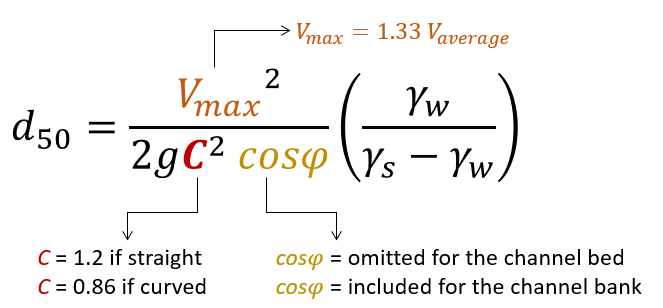
This works out to four basic equations:

Multiplying all the constant and coefficients, these equations become:

Where φ is the bank angle, already required for the USACE analysis.
Maricopa Channel and Bank Equations in HEC-RAS - Single Cross Section Analysis
As with the other Riprap and Scour Methods, access the Maricopa Riprap Calculator by selecting the Hydraulic Design Tools and then Selecting Riprap from the Type menu.
The target cross section is one of the main differences between the Maricopa method and the EM 1601 method. While the USACE method only uses the upstream refernce cross section for the straight, idealized channel above the bend, the Maricopa method uses the hydraulics from the local cross section under evaluation. Therefore, the Maricopa Method will be insensitive to the Reference Cross section Selected:
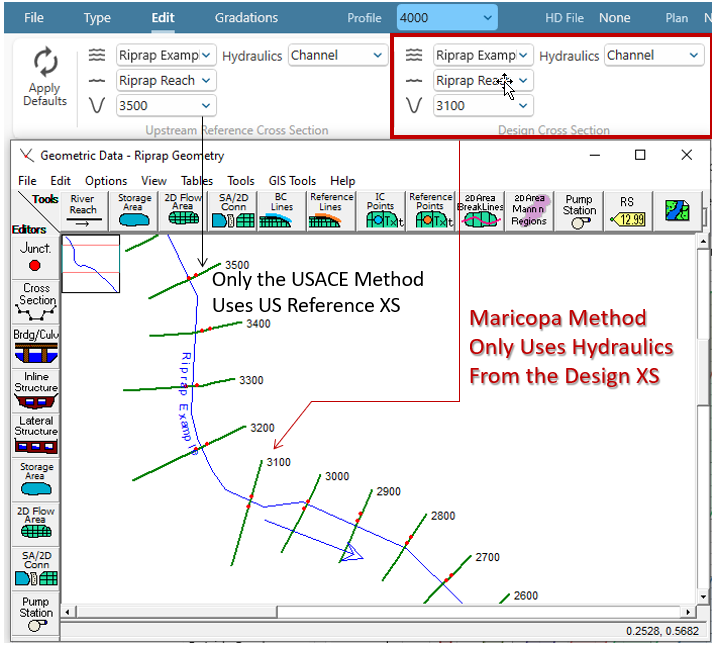
Access the Maricopa Method Inputs by selecting the Maricopa Method tab (see figure below). This is a modular tab, so users can move it around and stack it on the USACE Input Tab if they are not using both features. At the to of the Maricopa Editor, select Channel/Banks to use the equations above. The Maricopa Method also requires a Side Slope Angle in the global Input Data (see below) to compute bank gradations: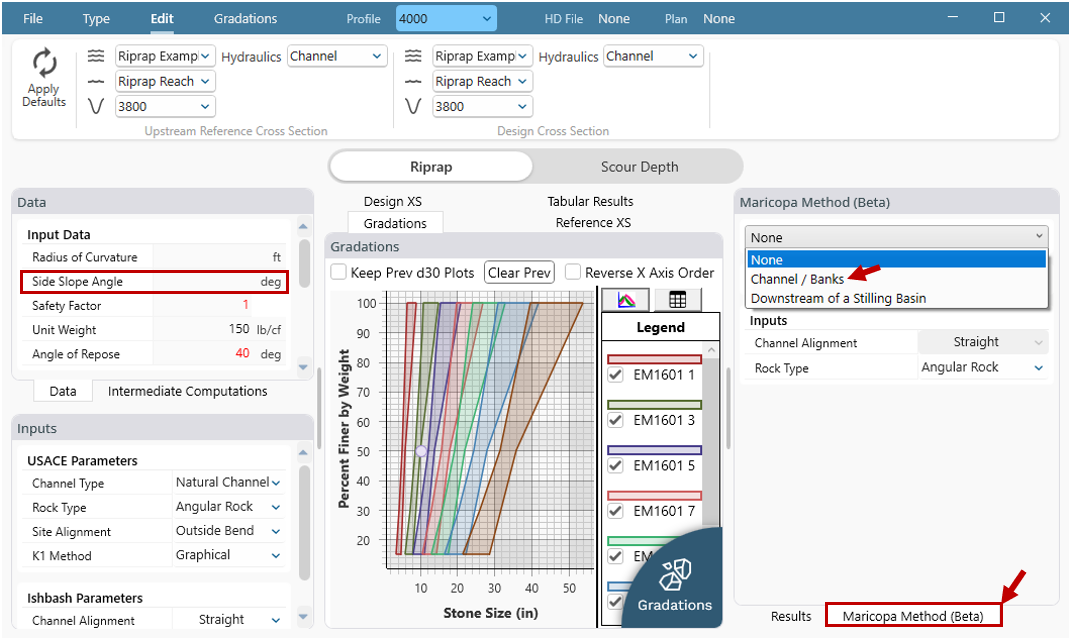
User Input
The Maricopa Method only requires three user decision. As mentioned (and illustrated) above, you must define the side slope angle under the general Input Data. HEC-RAS will use this side slope for all methods.
Then the user makes two choices under Inputs. 
Choose a Channel Alignment from the drop down. This drop down provides two choices: Straight and Curved. The Maricopa method recomends the Straight equation if the angle between the upstream flow direciton and the tangent of the bend is greater than 30 degrees
(see figure below modified from the Maricopa Manual and Simon, Li, and Associates 1981).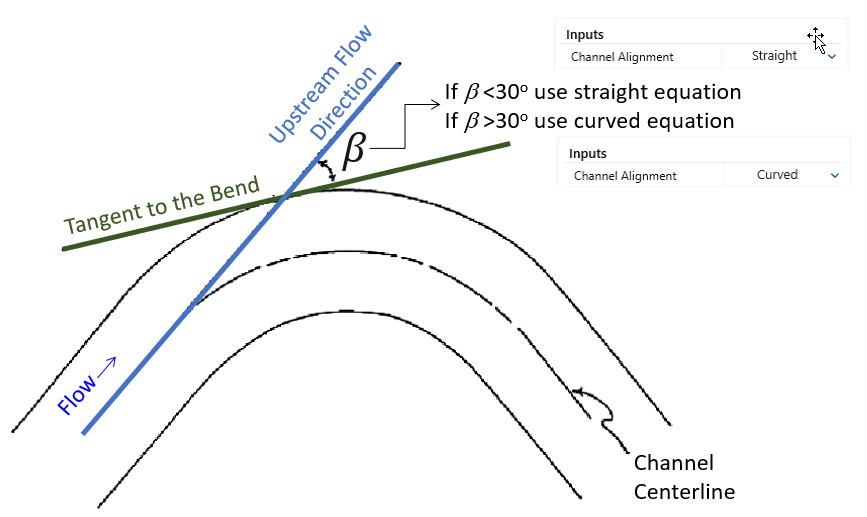
Finally, the user must specify whether the rock is angular or rounded. This has the same effect as it does on the USACE riprap method. Rounded rock diameters must be 30% larger (which translates to almost 100% larger by weight).
Single Cross Section Results
Gradations
The Maricopa Method computes gradational ranges for the whole riprap mixture based on the d50 (see chart below). For example, the range of acceptable d85s is a range between 1.2 and 1.4 times the d50. Weight ranges are computed the same way, with the weight thresholds of 100%, 85%, 50% and 15% finer all all specified as multiples of the median weight (W50).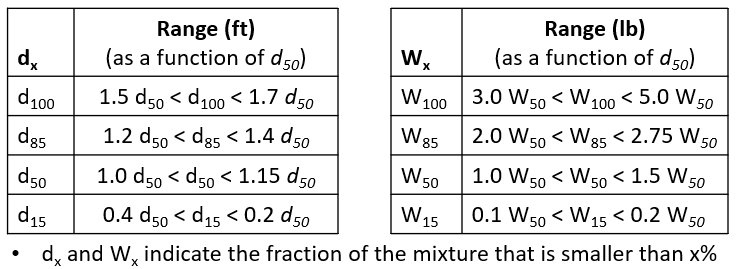
HEC-RAS translates these ranges into gradation bands in the gradation plotter. For example, in the plot below, HEC-RAS computes d50s for the channel and the banks (side slopes) with the Maricopa method. Then it calculates the ranges for the d100, d85, d50, and d15 according to the guidance in the above table, and plots it. This allows users to leverage the gradation tools, and compare locally available aggregate to the gradation bands suggested by the method.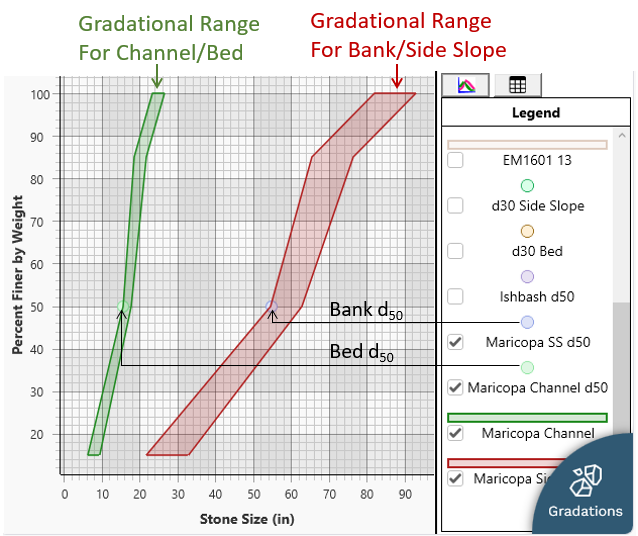
See the documentation on adding customized gradations to learn how to add available rock gradations to the riprap tool and evaluate them based on the gradation ranges plotted. (Note: If the Maricopa method is selected curves and polygons associated with the USACE method are deemphasized in the plot but still available for comparison. Unclick these polygons and points in the legend - as depicted in the figure above - to only plot Maricopa Results).
Multiple Cross Section Results
Because the Maricopa method uses the design cross section instead of an upstream reference cross section HEC-RAS can apply the method to multiple cross sections at once. The Riprap tool provides tabular data of the bank (side slope) and bed (channel) d50s for each cross section based on the categorical coefficients specified in the editor and the local, 1D, hydraulics at each cross section. If the user defines a reference and design cross section as well, these tabular data will also include a single USACE d30 (at the design location, but using the reference cross section hydraulics).
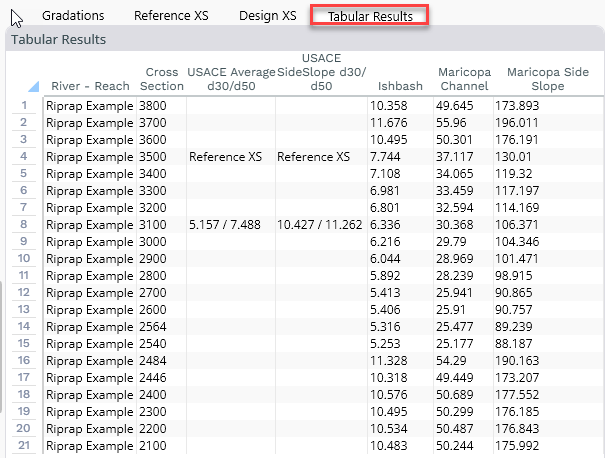
Evaluate if the Selected Coefficients are Appropriate for Each Cross section
Just because HEC-RAS will apply the Maricopa equations to all of the cross sections at once, does not mean that the equation parameters selected are appropriate for each cross section. The Maricopa approach requires users to specify whether the design cross section is in a straight or curved reach and updates the turbulence coefficient based on that information. Be careful of applying the same equation to long reaches with bends and runs/crossings.
Downstream of a Stilling Basin
The Maricopa method has several customized equations for specialized settings. This version of HEC-RAS includes the method to size the riprap downstream of a stilling basin.

To select this method, click the method box at the top of the Maricopa Method tab, and select Downstream of a Stilling Basin (see figure below). This will shift both the cross section and the global, tabular results to this equation. This method computes a single riprap d50 and gradation for the stilling basin-to-channel transition (i.e. it does not have separate bed and bank values).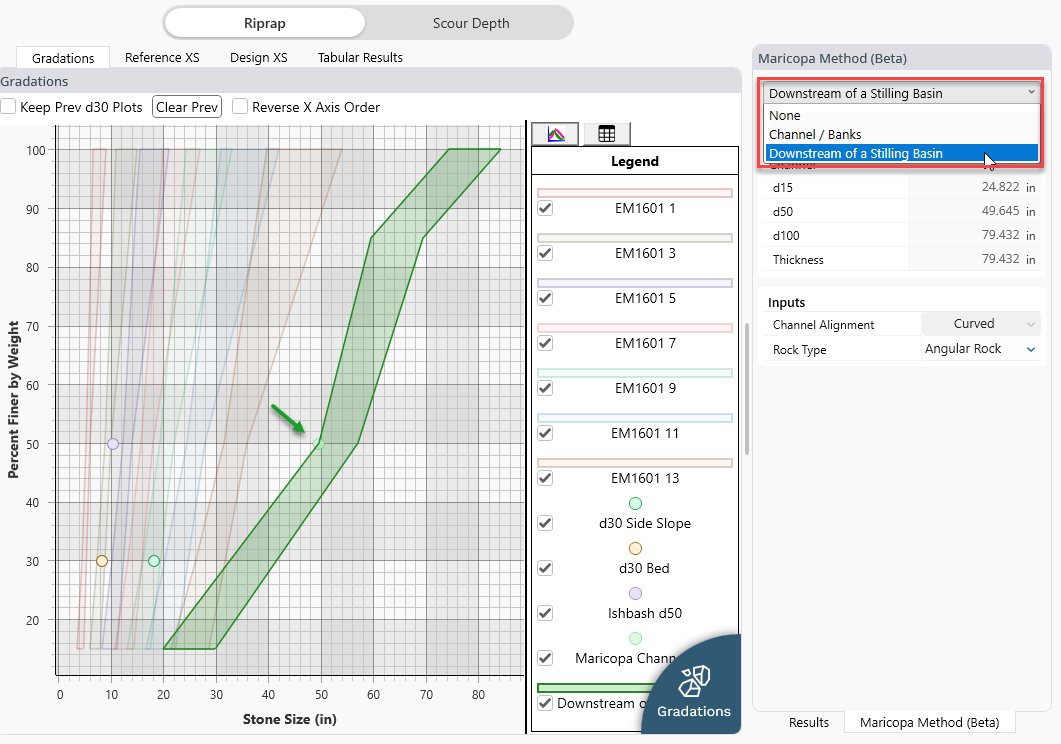
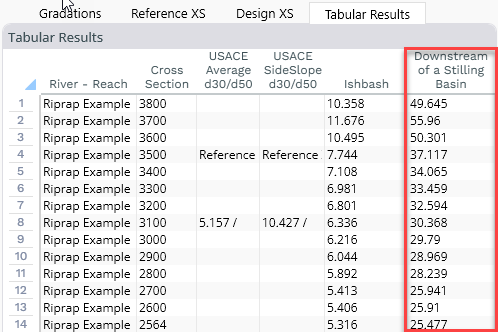
The riprap thickness calculation for this method is more complicated. It requires a different thickness for the "horizontal" and "sloped" portions of a pre-defined stilling basin design (see figure below).
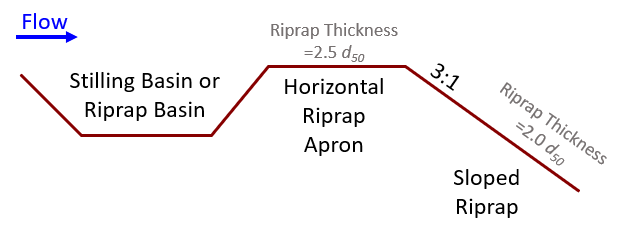
The thickness on the horizontal apron downstream of a stilling basin is 1.5d100 or 2.5d50. The method uses 2.0d50 for the riprap thickness on a 3:1 slope downstream of the stilling basin.
Compute riprap thickness downstream of a stilling basin manually for version 6.3
HEC-RAS does not compute these thicknesses in version 6.3. Compute these externally, based on your design configurations.
References
Maricopa County, , Drainage Design Manual for Maricopa County, Arizona: Hydraulics, 738 p.
Simons, Li and Associates, Inc., 1981, Design Guidelines and Criteria for Channels and Hydraulic Structures on Sandy Soil, Urban Drainage and Flood Control District and City of Aurora, Colorado.
Acknowledgements
This work was funded by the Flood Control District of Maricopa County
